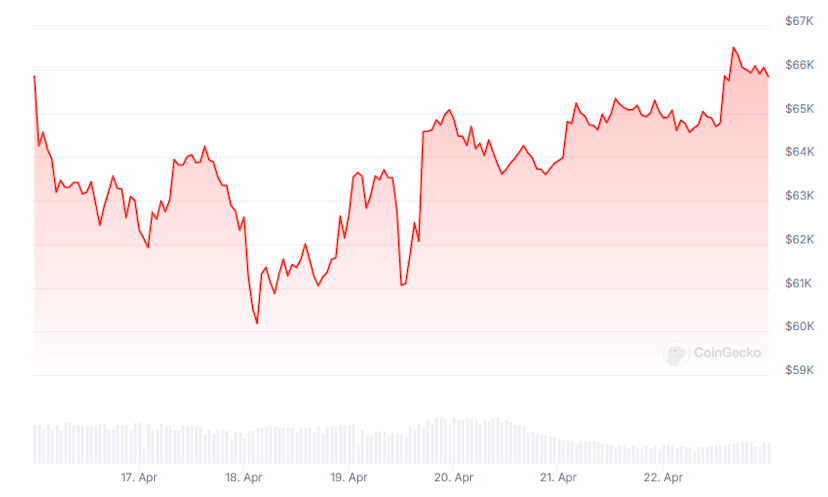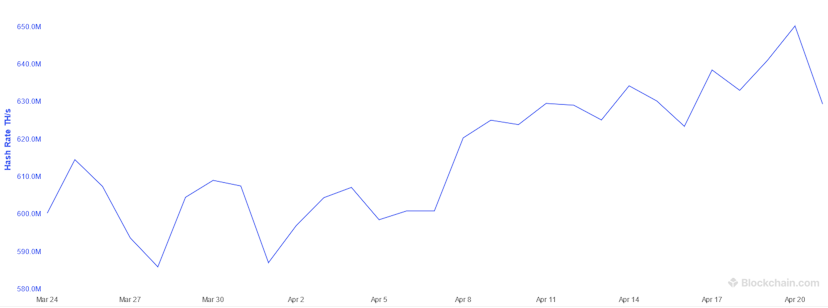Bitcoin Mining Stocks Thrive While Hash Rate Slides Post Halving
Leading mining stocks rallied by more than 17% since Tuesday.
By: Mehab Qureshi • Loading...
Markets
Shares in major Bitcoin mining firms have surged by more than 17% since April 16 amid Bitcoin’s fourth quadrennial block reward halving.
According to Google, Marathon Digital Holdings (MARA), Riot Blockchain (RIOT), and CleanSpark (CLSK) rallied 17.5%, 17.8%, and 22.6% from last Tuesday’s lows respectively.
The impressive performances were capped off by strong after-hours trading on Friday, with MARA, RIOT, and CLSK gaining 1.52%, 0.84%, and 0.97%. For comparison, leading U.S. stocks suffered their sixth-consecutive drawdown on the same day, with the S&P 500 dipping 0.88% and the Nasdaq Composite Index dropping 2.05% during the same session.
The Bitcoin halving slashed miner rewards by 50% from 6.25 BTC to 3.125 BTC per block. The event is intended to bolster scarcity and decrease the inflation of BTC by reducing block rewards by half every four years.
In a recent note to investors, Reginald Smith, an analyst at JPMorgan predicted that the Bitcoin halving would drive “heightened volatility and trading volume” for both Bitcoin mining stocks and BTC.
Data from CoinGecko shows large swings in Bitcoin’s price over the past week, with BTC crashing 9% from April 16 to a local low of $60,181 two days later. However, BTC quickly recovered its losses to last change hands for $65,883.

Miners grapple with Bitcoin halving
While the Bitcoin halving is tipped to precede future bullish price action by reducing the rate of new BTC issuance, Bitcoin miners must now grapple with their revenue dropping by 50%. Although some miners will maintain profitability by keeping energy costs low or scaling up operations, inefficient miners will be forced to shut down.
Data from Blockchain.com shows that Bitcoin’s network hash rate — the total computational power of Bitcoin’s Proof of Work miners — has already slumped 3.2% to 629.4 exahashes per second (EH/s) from an all-time high of 650.3 EH/s on April 19 as unprofitable miners cease operations.
“Mining profitability was lower in the first two weeks of April as network hashrate growth outpaced Bitcoin price appreciation,” Smith said.

In a recent report, CoinShares found that Bitcoin’s hash rate fell by 9% on average during the six months following previous halving events as inefficient miners were purged from the network.
In February, Galaxy Digital predicted that between 15% and 20% of Bitcoin’s hash rate from ASIC miners could be forced offline as older machines are rendered unprofitable after the halving. However, a February report from Bloomberg indicated that many Chinese mining firms are shipping outdated mining machines to Ethiopia in search of low overheads on electricity.
Miners migrate to Bitcoin Cash
Despite Bitcoin’s block rewards getting cut in half, many displaced Bitcoin miners may find refuge by migrating to rival Proof of Work networks.
Ryan Song of CoinWestern Ventures, a Bitcoin mining consultancy firm, told The Defiant that many miners are looking to Bitcoin Cash, a Bitcoin fork that shares the same Proof of Work consensus mechanism, to ensure profitability.
“Savvy miners are always seeking profitability, and with the new dynamics post-Bitcoin halving, Bitcoin Cash appears to offer a more lucrative avenue,” Song said. “Miners are beginning to pivot to chains where their chances of earning mining rewards are higher."
Indeed, Bitcoin Cash’s hash rate jumped from 1.7 EH/s on April 16 to a local high of more than 6 EH/s on April 21, according to Coinwarz. However, Bitcoin Cash’s hash rate has since fallen to roughly 4 EH/s.
Advertisement
The Defiant Daily
“an industry must-read”
Get an edge in Crypto with our free daily newsletter
Know what matters in Crypto and Web3 with The Defiant Daily newsletter, Mon to Fri
90k+ Defiers informed every day. Unsubscribe anytime.